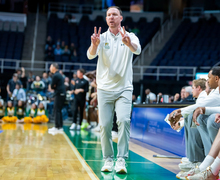Syverud visits Micron headquarters, sets sights on joint academic programs
Nina Gerzema | Asst. Photo Editor
Syverud called the meetings “productive,” and said the plans and goals laid out with Micron leaders are setting up the next stage in the university’s partnership with the semiconductor manufacturing company moving forward.
Get the latest Syracuse news delivered right to your inbox.
Subscribe to our newsletter here.
Syracuse University Chancellor Kent Syverud attended Wednesday’s University Senate meeting via Zoom from Boise, Idaho, where he and university administrators met with Micron officials at the company’s headquarters to discuss collaborative programs at SU.
Syverud called the meetings “productive,” and said the plans and goals laid out are setting up the next stage in the university’s partnership with Micron moving forward.
“It’s apparent that the university’s relationships with Micron are going to be long-term and will cut across many schools, colleges, and units,” Syverud said.
On Oct. 4, Micron announced it would be investing up to $100 billion to build a semiconductor chip manufacturing plant in Clay, New York, around 15 miles north of Syracuse. At the end of October, President Joe Biden visited Syracuse to address the community on Micron’s investment in a speech at Onondaga Community College, in which he called the plant “one of the most significant investments in American history.”
Syverud met with Micron leaders alongside Mike Haynie, SU’s vice chancellor for strategic initiatives and innovation, and Gretchen Ritter, SU’s vice chancellor, provost and chief academic officer. Syverud didn’t mention any specific plans in motion but said Micron and SU are making progress in developing joint academic programs.
“This visit has been the next stage in creating a clear structure and to enable… university collaboration with Micron,” he said.
The University Senate also discussed campus safety in the wake of a recent shooting at the University of Virginia, where suspect Christopher Darnell Jones Jr. allegedly shot and killed three UVA students and injured two others.
Robert Hradsky, SU’s vice president of the student experience, outlined the university’s mechanisms to identify threats on campus, detailing how SU would respond in the event that students, faculty, or staff identify a threat.
In an initial screening, officials in response to a threat would conduct a criminal background check, look over the social media accounts of someone identified as a threat and investigate the person’s conduct history at the university, Hradsky said.
Hradsky added that after the initial screening, the university would launch an inquiry to review the evidence. From there, he said the university has a “number of tools” to address the situation, which includes required counseling for someone who poses a threat or potential removal of that person from the SU community.
“The team will develop and implement an intervention plan where we engage directly with the individuals involved, and then again, meet on a regular basis to follow up and make sure that we are appropriately managing the threat,” Hradsky said.
The university will continue to host training sessions on campus to help faculty and staff become more informed on identifying and handling threats as well as on how to make appropriate referrals through the university.
On Nov. 17, four days after the UVA shooting, SU collaborated with Albany’s FBI office to host active shooting training for SU faculty and staff in Hendricks Chapel. The Department of Public Safety’s Crime Prevention Unit hosted 56 training sessions between Aug. 1 and Nov. 22, including a simulated response to an active shooting situation, said DPS chief Craig Stone.
Hradsky also encouraged university faculty and staff to complete the Kognito training, a practice-based digital learning service which trains school and campus communities in practices intended to improve mental health, saying the program would help the SU community identify “those in distress” and know how to respond.
Hradsky stressed the importance of the university community being proactive in identifying threats on campus.
“I would say that anytime you have any concerns that there’s a potential threat, whether it feels immediate or it’s unclear, we’d much rather have you put that on our radar so that we can make an assessment and look at any sorts of ways that we might be able to intervene should they come on campus,” Hradsky said.
Syverud also noted the arrest of Libyan intelligence operative Abu Agila Mohammad Mas’ud Kheir Al-Marimi – who allegedly played a role in the bombing of Pan Am flight 103 over Lockerbie, Scotland – calling it a “significant milestone.”
In December 2020, the U.S. charged Mas’ud for allegedly building the explosive device detonated on Pan Am 103. The bombing of Pan Am 103 on Dec. 21, 1988 led to the deaths of 270 people onboard and on the ground, including 35 SU Abroad students returning to New York from a semester in London.
Other Business:
- Ritter said increasing the stipend levels has been elevated to a “high priority” for the university after the issue was discussed at a recent Graduate Student Organization meeting. Ritter said the university will increase the minimum stipend for master’s students on a full-time assistantship to $20,000, while the minimum stipend for Ph.D. students will be increased to $22,000. Ritter added that SU’s colleges and schools will be “expected” to increase stipends by 3% on average overall next year.
- The USenate’s Committee on Curriculum said the committee has 748 total curriculum proposals to review and potentially implement in the 2023-2024 academic year.
Published on December 15, 2022 at 12:09 am
Contact Dominic: dcchiapp@syr.edu | @DominicChiappo2






